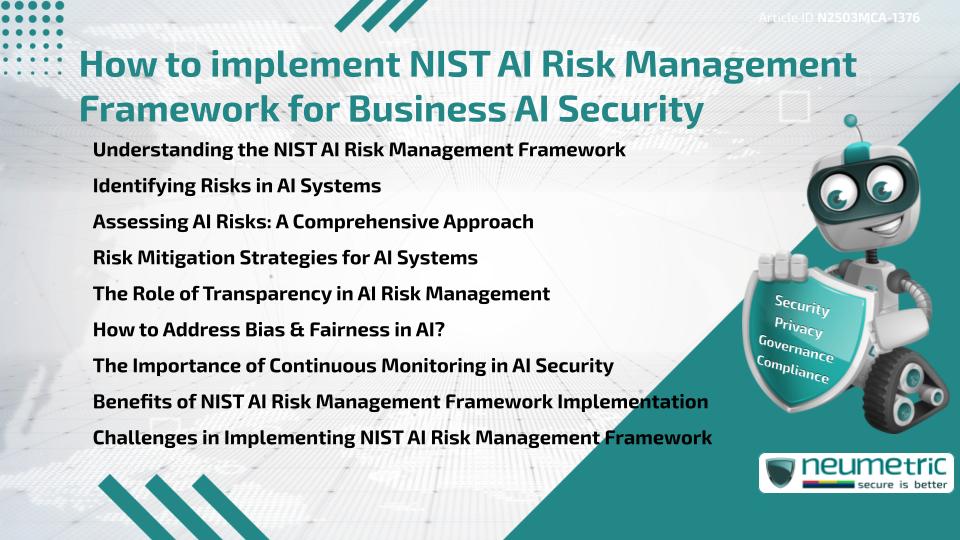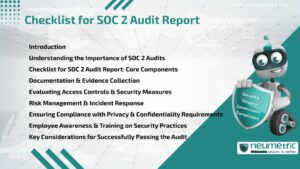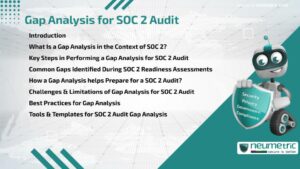Table of Contents
ToggleIntroduction
The Rapid Advancement of Artificial Intelligence [AI] Technologies has brought about significant improvements across Industries. However, as AI Systems become more Complex & Integrated into Business Operations, ensuring their Security & Reliability becomes increasingly important. The National Institute of Standards & Technology [NIST] has developed the AI Risk Management Framework to help organisations Identify, Assess & Mitigate Risks associated with AI Technologies.
For Businesses looking to protect their AI Systems & build trust with Stakeholders, understanding How to implement NIST AI Risk Management Framework? is crucial. This Framework provides a Structured approach to managing AI Risks, ensuring that AI Systems are Ethical, Secure & Transparent. In this Article, we will explore the Key Steps in Implementing the Framework effectively, its Benefits & Potential Challenges.
Understanding NIST AI Risk Management Framework
The NIST AI Risk Management Framework is Designed to provide organisations with Guidelines for managing the Unique Risks posed by AI Systems. The Framework is based on a Comprehensive Risk management approach that includes the Identification, Assessment & Mitigation of Potential Risks throughout the Lifecycle of AI Systems. Key Elements of the Framework include:
- Risk Identification: Identifying Potential Risks related to AI Systems, such as bias, Security Vulnerabilities & Ethical concerns.
- Risk Assessment: Evaluating the Severity & likelihood of these Risks, considering their Potential impact on Business Operations.
- Risk Mitigation: Implementing Strategies & Controls to reduce or eliminate Identified Risks, such as improving Transparency or reinforcing Security measures.
By following the NIST AI Risk Management Framework, organisations can Systematically address the Risks associated with AI Technologies while ensuring Compliance with relevant Regulations & Standards.
Steps for Implementing NIST AI Risk Management Framework
1. Identify AI Risks
The First Step in How to implement NIST AI Risk Management Framework? is to Identify the Risks associated with your AI Systems. Risks can vary depending on the type of AI Technology used, its Application & the Data it Processes. Some common AI-related Risks include:
- Bias & Fairness: AI Models may unintentionally Perpetuate Biases present in Training Data, leading to Unfair Decisions or Discriminatory outcomes.
- Security Vulnerabilities: AI Systems may be susceptible to Attacks that compromise their Integrity or result in Data Breaches.
- Ethical Concerns: AI Decisions may not align with Societal values or Ethical Standards, leading to Reputational damage.
- Operational Risks: AI Models may malfunction or behave Unpredictably, leading to disruptions in Business Operations.
To Identify these Risks, engage relevant Stakeholders, including Data Scientists, Business leaders & Security Experts, to Review the AI Systems in use & Assess Potential Risks from multiple Perspectives.
2. Assess the Risks
Once Risks are identified, the next Step in how to implement NIST AI Risk Management Framework? is to Assess their Severity & Likelihood. Risk Assessment involves understanding the Potential impact of each identified Risk on your organisation. This includes evaluating Factors such as:
- Likelihood: How likely is it that the Risk will Materialize?
- Impact: What would the Consequences be if the Risk were to Occur?
- Mitigability: Can the Risk be Mitigated or Controlled through preventive measures?
Use a Risk Matrix to categorise Risks based on their Likelihood & Impact. This will help prioritise the most Critical Risks that need immediate Attention.
3. Implement Risk Mitigation Strategies
After Assessing the Risks, the next Step is to implement Risk mitigation strategies. These strategies should be tailored to the specific Risks identified during the Assessment Phase. Common AI Risk mitigation Techniques include:
- Bias Mitigation: Implement Algorithms or Data Processing Techniques that detect & reduce bias in AI Models.
- Data Privacy & Security: Strengthen Data Security measures, including Encryption, Access Control & Secure Data storage, to protect Sensitive Information.
- Transparency & Explainability: Make AI Decision-making processes more Transparent by using Techniques that allow Stakeholders to understand & trust AI outcomes.
- Ethical Oversight: Establish an Ethical Review process to ensure that AI Systems align with organisational Values & Societal expectations.
The Goal of these mitigation strategies is to reduce the Likelihood & Impact of identified Risks, ensuring that AI Systems are Secure, Fair & Trustworthy.
4. Monitor & Review AI Systems
Implementing the NIST AI Risk Management Framework is not a One-time Activity. It’s important to continuously Monitor & Review your AI Systems to ensure they remain Compliant with the Risk management Framework. Regular Audits & Assessments should be conducted to:
- Monitor AI Performance: Ensure AI Systems continue to Function as intended & do not exhibit any unforeseen issues.
- Assess New Risks: New Risks may arise as AI Technologies evolve or as new Data is Integrated into Models. Stay alert for Emerging Threats.
- Update Mitigation Strategies: As the Business environment changes, Update your mitigation strategies to address new Risks or Weaknesses in existing Controls.
Continuous monitoring ensures that AI Systems remain safe & aligned with the organisation’s Risk management Objectives over Time.
Benefits of Implementing NIST AI Risk Management Framework
- Enhanced AI Security: By Identifying & Mitigating Potential Security Risks, organisations can Safeguard Sensitive Data & prevent Breaches.
- Ethical AI Deployment: The Framework ensures that AI Technologies are Deployed responsibly & in alignment with Ethical Standards.
- Regulatory Compliance: Many Regulations now require organisations to manage AI-related Risks. The NIST Framework helps ensure Compliance with these Regulations.
- Business Continuity: Proper Risk management reduces the likelihood of AI System Failures, ensuring that Business Operations run smoothly & without Disruptions.
Limitations & Challenges
While the NIST AI Risk Management Framework provides a Solid Foundation for managing AI Risks, there are Challenges to its implementation:
- Complexity: The Framework requires a deep understanding of both AI Technologies & Risk management Principles, which can be difficult for organisations without the right Expertise.
- Resource Intensive: Implementing the Framework can be Time-consuming & require significant Resources, especially for large organisations with complex AI Systems.
- Evolving Nature of AI: AI Technologies are Rapidly evolving, meaning that the Risk landscape is constantly changing. Continuous Monitoring & Adaptation are required to keep Pace with these Developments.
Conclusion
Implementing the NIST AI Risk Management Framework is essential for Businesses looking to ensure the Security, Fairness & Ethical use of their AI Technologies. By following a Structured approach to Risk identification, Assessment & Mitigation, organisations can manage AI-related Risks effectively & build Trust with Stakeholders. While the Process can be Resource-intensive & Complex, the long-term Benefits of enhanced AI Security, Regulatory Compliance & Business Continuity make it a worthwhile Investment.
Takeaways
- The NIST AI Risk Management Framework provides a comprehensive approach to managing Risks associated with AI Systems.
- The Key Steps in Implementing the Framework include Identifying, Assessing & Mitigating Risks, followed by Continuous Monitoring.
- Implementing the Framework helps Businesses Build Secure, Ethical & Transparent AI Systems.
- The Framework can help ensure Regulatory Compliance & improve Trust with Customers & Stakeholders.
FAQ
What is the NIST AI Risk Management Framework?
The NIST AI Risk Management Framework provides Guidelines for Identifying, Assessing & Mitigating Risks related to AI Systems, Focusing on Security, Transparency & Ethical use.
Why is the NIST AI Risk Management Framework Important for Businesses?
The Framework helps Businesses Secure their AI Systems, reduce Risks, ensure Ethical AI Deployment & Comply with emerging Regulations on AI Technologies.
How can Businesses implement the NIST AI Risk Management Framework?
Businesses can implement the Framework by Identifying Risks, Assessing their impact, applying Mitigation strategies & Continuously monitoring AI Systems for Compliance & Performance.
Is Continuous monitoring required after Implementing the NIST AI Risk Management Framework?
Yes, Continuous monitoring is Crucial to ensure AI Systems remain Secure, Ethical & Compliant with Regulations as Technologies evolve.





